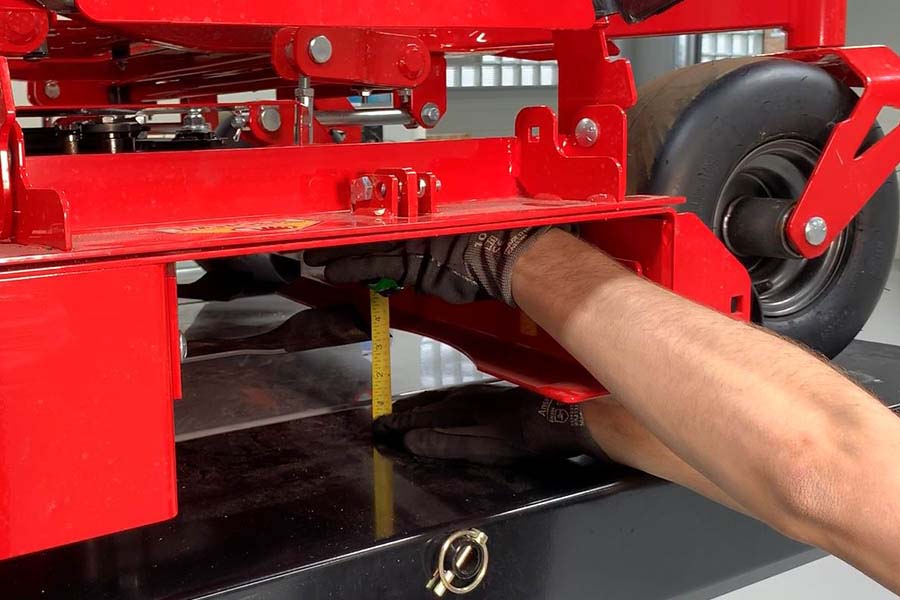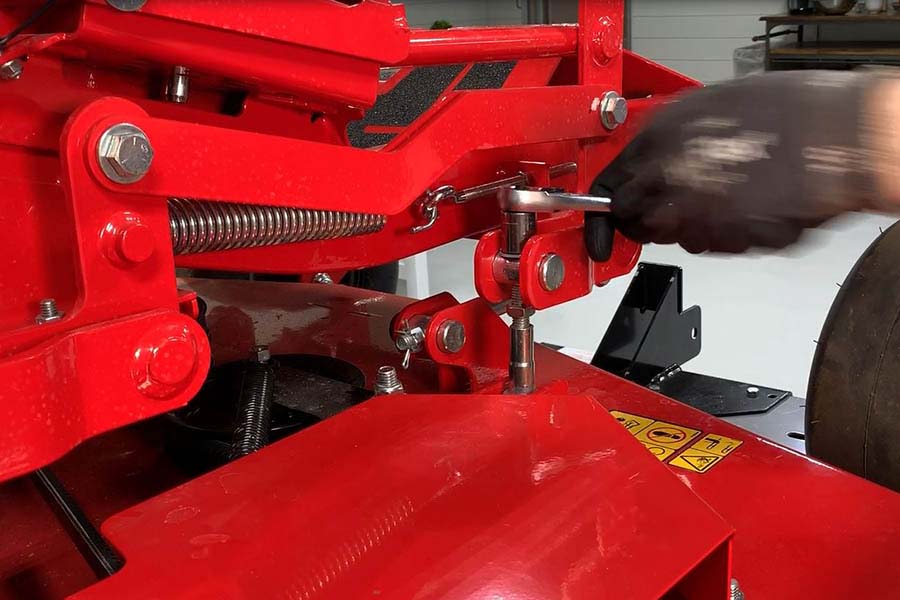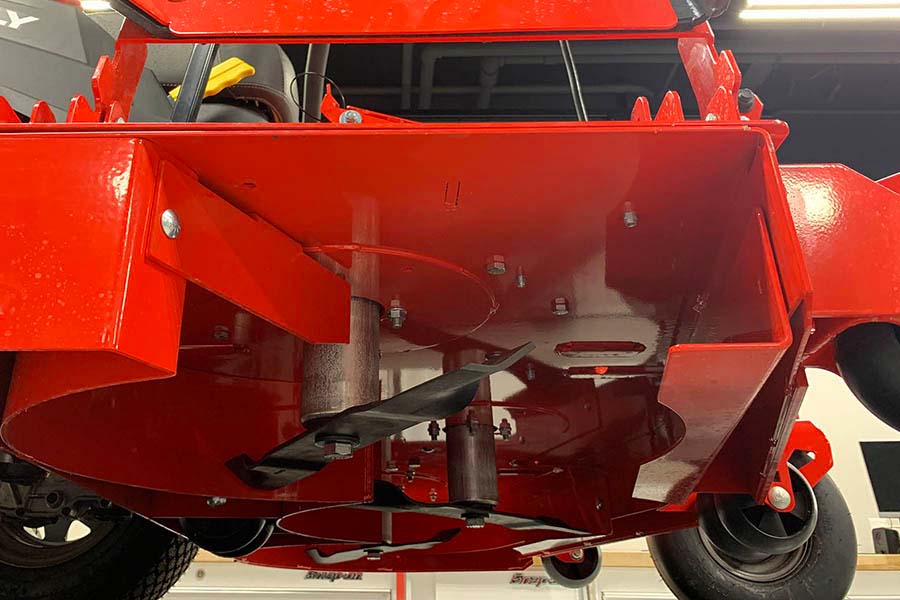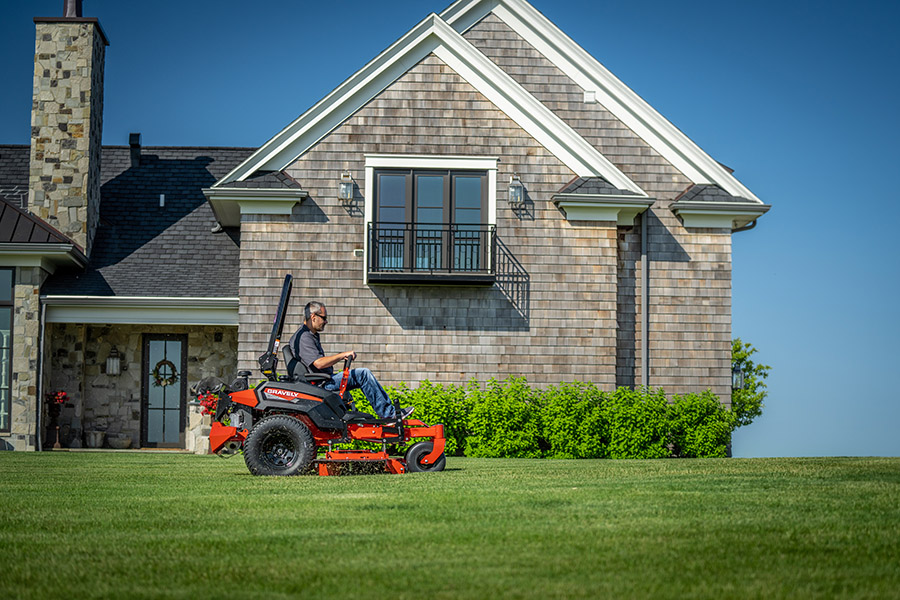Getting the Best Lawn Mower Cut Quality
How to get the best looking lawn
Cutting the lawn has more purpose than making tall grass short. It's about crafting landscapes that bring pride, landscapes that host parties and landscapes that literally work for you. By delivering superior cut quality for your clients, your reputation as a sharp landscaper will help retain current clients and be a selling point for new ones.
Read the following tips to learn how to get the sharpest looking landscapes. On a zero-turn lawn mower, there are both adjustments and techniques landscapers can make and perform to ensure a smooth, even and appealing result with each mowing.
Adjust lawn mower deck pitch
Fine tuning a mower deck enables the aerodynamic design of the cutting chamber to lift grass, cut it evenly and discharge it effectively.
What is mower deck pitch?
Lawn mower deck pitch, or sometimes referred to as, "rake," is the tilt of the mower deck from front to back. Forward deck pitch creates an air seal at the front of the deck when the blades are rotating. This seal limits air entry into the cutting chamber to the rear of the deck, allowing the aerodynamic design of a Gravely lawn mower deck to maximize grass lift and cut evenly. This design results in a superior cut quality and an even discharge that's less likely to clump.
For most effective results, a lawn mower deck should have a pitch, or height difference of 1/8-inch to 1/2-inch between the front of the deck to the back of the deck. Naturally, this makes the sweet spot about 1/4-inch of pitch, depending on the mower model. In any case, the front of the deck should be pitched lower than the deck rear. Be careful not to pitch too much that you start scalping lawns.
How to adjust lawn mower pitch
All Gravely decks are built so their owners can adjust deck pitch quickly and easily. There's no special tools or mechanical training required to complete this procedure, either. Just a couple wrenches and a few pieces of hardware. Before you begin, park the mower on a flat, level surface, stop the engine, remove the key, check that the tire pressures are equal and grab a tape measure.
Check pitch
As directed in the operator's manual:
- Raise the mower deck to a cutting height of 3.5 inches.
- Manually and carefully turn the lawn mower blades so they're positioned front to back. When manually turning blades, always grab the dull edge of the blade.
- Measure:
- The distances between the front tips of the outer blades and the ground.
- The distances between the rear tips of the outer blades and the ground.
- If front measurements are lower than the rear measurements by less than 1/8 inch or more than 1/2 inch, adjust pitch.

Adjust pitch
Deck pitch can be adjusted by lowering the front of the deck, raising the rear of the deck or a combination of both. Be sure to make adjustments so that the distances of your final measurements at the front of the deck accurately reflect the cutting height of 3.5 inches that was set earlier.
To lower the high side of deck:
- Loosen jam nuts against deck lift links.
- Turn adjustment bolts counterclockwise.
- Retake measurements and continue adjustment, if necessary.
- Tighten jam nuts against deck lift links.

To raise the low side of deck:
- Loosen jam nuts against deck lift links.
- Turn adjustment bolts clockwise.
- Retake measurements and continue adjustment, if necessary.
- Tighten jam nuts against deck lift links.
After pitch adjustment is complete, check deck level.
Leveling your lawn mower deck
Level the mower deck to ensure grass cutting height is even across the width of the deck. This will help ensure a smooth and seamless side-by-side blend between each row of freshly cut grass.
What is lawn mower deck leveling?
This is easier to understand than deck pitch. Deck leveling is simply making the cutting height on the left side of the deck even with the cutting height on the right side of the deck. In all cases, decks should be level with as little variance between each side of the cutting deck as possible. No variance between the left and right side of the deck is best.
How to level the mower deck
Leveling a Gravely lawn mower deck is done the same way as pitching a Gravely mower deck, except it's adjusting the deck height from side to side, not back to front. Same components and tools with pitching a mower deck, and as before, start with the unit parked on a flat, level surface, inflate the tires to specification and grab a tape measure.
Check lawn mower deck level
As directed in the operator's manual:
- Raise the mower deck to a cutting height of 3.5 inches.
- While wearing thick, sturdy gloves, manually and carefully turn the blades so they're positioned side to side. When manually turning blades, always grab the dull edge of the blade.
- Measure:
- The distance between the left blade's left cutting edge and the ground.
- The distance between the right blade's right cutting edge and the ground.
- If the distance between the left blade tip and the ground is 3/16 inches greater than or less than the distance between the right blade tip and the ground, level the deck.
How to level your lawn mower deck
As directed in the operator's manual
To lower the high side of deck:- Loosen jam nuts against deck lift links.
- Turn adjustment bolts counterclockwise.
- Retake measurements and continue adjustment, if necessary.
- Tighten jam nuts against deck lift links.
- Loosen jam nuts against deck lift links.
- Turn adjustment bolts clockwise.
- Retake measurements and continue adjustment, if necessary.
- Tighten jam nuts against deck lift links.
How to sharpen lawn mower blades
Same as with dull knives or scissors – they don't cut efficiently and results in duplicate effort. On a mower, dull lawn mower blades leave behind stragglers and require the terribly inefficient practice of mowing the same rows twice.
Dull blades may require a total replacement, which isn't bad since new blades are relatively cheap and easy to replace. However, if the blades aren't worn too far, they can be sharpened without spending money on new blades. Be aware that blades should not be sharpened if more than a half-inch of the blade material is worn away (by previous sharpening or wear) or if the air lift is eroded. If the air lift is eroded, blades can no longer lift grass effectively and cut evenly. Blades that are bent or broken should be discarded.
- Read the safety instructions and the procedure instructions in the unit's operator's manual.
- Remove the mower deck according to the instructions in the operator's manual.
- Remove the blades according to the instructions in the operator's manual.
- File or grind an equal amount of blade material from each cutting edge until sharp. Do not change angle of cutting edge or round the corner of the blade.
- Slide the blade onto an unthreaded bolt and hold the bolt horizontally. Position the blade horizontally and check for blade balance. This is critical. If the blade moves, sharpen the heavy end until the blade remains balanced in a horizontal position on the unthreaded bolt.
- When the blade is sharpened and balanced adequately, reinstall it under the mower deck and torque it to the specification listed in the operator's manual.
- Reinstall the mower deck.
Cleaning your mower deck
Mower decks packed with grass clippings, dirt and debris can damage your mower, affect cut quality and hurt lawns. Grass, dirt and debris holds moisture that corrodes bare metal on the spindles and lawn mower blades, weakening them. Additionally, grass-packed cutting decks can harbor fungi and bacteria that can spread to other lawns and damage them.
Grass buildup around the discharge area can prevent clippings from discharging evenly and could lead to clumping. Grass buildup under the deck can also affect the aerodynamics of the cutting chamber, disrupt the air lift under the deck (detailed in What is mower deck pitch?) and affect the cut quality.
How to clean a lawn mower deck
- Remove the lawn mower deck and blades as instructed in the operator's manual.
- Remove clumped grass from under the mower deck and wash with low-pressure water and a mild soap solution until all dirt, grass and debris is washed away from the deck.
- Reinstall the deck and blades according to the instructions in the manual.

Good lawn mowing techniques
Sometimes, getting a better cut quality can be achieved by breaking a few bad habits like mowing too fast, mowing in the same pattern and cutting grass too short.
Why you shouldn't mow lawn too fast
For busy landscapers, efficiency is important. And while landscapers will find many creative ways to shave time off each job, patience on the jobsite yields better results. Driving faster than the mower blades and deck can process overwhelms the deck and leaves behind stragglers and clumping. Slowing down the drive speed of a mower allows the blades enough time to lift, cut and discharge grass clippings evenly.
Why you should mow in different patterns in lawns
After mowing the same properties, landscapers will learn the best way to navigate through their clients' properties and will sometimes stick to one efficient mowing pattern. However, mowing in the same pattern is bad for lawns.
Grass is like hair. If it's accustomed to being pushed in the same direction, it learns which way to fall. After mowing in the same paths cut after cut, grass falls to one direction and doesn't stand straight up, making it more difficult for the mower to lift the grass and cut it evenly.
Additionally, mowing in the same pattern creates ruts. The weight of a mower driving over the same rows with each mowing causes the soil under a mower's wheels to become compacted. As soil compacts, it restricts water, air and nutrients from reaching grass roots, leading to grass discoloration in those mower tracks.
To avoid these issues, landscapers should mow in a different pattern that crisscrosses the pattern of the previous mowing.
EXPLORE THE BENEFITS OF MOWING PATTERNS
Why you shouldn't cut grass too short
Grass that's kept longer grows healthier. 
Grass that's cut too short becomes stressed because it uses its energy re-growing what was just cut instead of growing its root system. Longer grass makes healthier lawns because longer grass has deeper root systems which access moisture and nutrients more effectively. Additionally, longer grass helps prevent the ability for weeds to take hold in the soil and germinate because tall grass blocks sunlight from those weeds.
Landscapers should cut no more than one-third of the length of grass with each mowing.
Best mowers for good cut quality
Performing service and adjustments on any lawn mower makes a big difference in cut quality, but you'll never get the best cutting quality without having the right equipment. Consumers have numerous choices in a commercial lawn mower, but they're not built alike.
Gravely commercial lawn mowers are designed for landscapers. Not only is a Gravely durable, reliable and comfortable, but each Gravely is designed to deliver superior cutting results.
CHOOSE THE RIGHT MOWER FOR YOU
Strong deck stability
As opposed to decks that shake excessively when cutting, Gravely decks are sturdy and move with the contours of each landscape, ensuring an even cut.
Cutting deck dimensions
The deep depth of a fully fabricated Gravely commercial mower deck processes greater volumes of grass faster with reduced need to compromise speed for quality on the jobsite.
Superior deck aerodynamics
Grass is lifted and discharged evenly and effectively, meaning there's less chance for stragglers and clumping.
Constant belt tension
Gravely's trademarked constant belt tension, or CBT, applies the same tension to a brand new mower belt than it does to an older, stretched mower belt. This ensures consistent blade tip speed and cutting results throughout the life of the belt, even as it wears.
Lawn mower dealers near me
Ready to learn more about the machines that have been shaping the American landscape for over a century? Stop by your local Gravely dealer to explore Gravely's full product lineup and to get replacement parts like belts, blades and more. Add a Gravely lawn striper kit this season to enhance each lawn by giving it that professional, finished look.
LEARN MORE FROM THE GRAVELY BLOG
